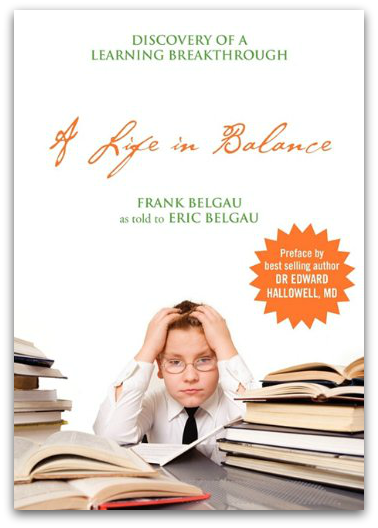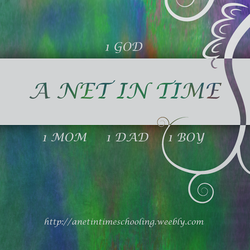Vendor Company Name AND Link: Learning Breakthrough Program
Product Name AND Link: A Life in Balance (book) - I received a PDF copy
Author: Eric Belgau telling the story of Frank Belgau.
Age Range: This is a book for parents. This would also be applicable for older teens, but this is mainly for adults.
Price: $16.94
Chapter 1: The Early Days.
Thoroughly enjoyed reading this chapter. Makes me wonder if (though my boy is not learning challenged) is any of the exercises in the book might help him gain confidence in his reading. :)
Chapter 2: The Slow Kid in a Fast Family
This chapter showed me where some of his inspiration came from. :)
"When I got back to school, I discovered that my summer of exercise had had another benefit. I could read."
Chapter 3: Unseen Magic
the love of being a scientist... I could just see him bursting through that door. :)
Chapter 4: The Right Stuff.
Learned an important concept: that there are basic operating principles to every process. And there are folks out to make things look good and others who more importantly want things to work good. Learning how society operates is important. React to it with honour.... and be mindful not to fly over volcanos. (read the book folks!)
Chapter 5: Beginning to Teach .......
Teaching Art, taught to be a better scientist.The story of my life as a teacher and therapist, is a story of people.
In this next section I found that generally a time of learning was followed by a time of putting ideas into practice and increasing his understand and knowledge. Teacher and then students. Both taught him, just in different ways. :)
Chapter 6: Edward
it was so neat to read the story of Edward. Seriously, get the book and read it! :)
Chapter 7: F. E. McGahan
"The mechanisms of that learning, how it occurs and how to make it better, are fundamentally fascinating." I think of how fascinating it is to watch my son learn and how so many things can influence what and how it is he learns. Sometimes it's merely listening, others times it is doing, sometimes it's a mixture of things. In this chapter the author figures out that taste, smell, hearing, sight, touch, and movement—...the six senses all play a role in helping people learn.
Chapter 8 The North Shore Students
"The more I challenged my students, the more they challenged themselves to succeed". and with this I was challenged. I need to challenge my boy a bit more. Encourage him yes, but challenge him. I know he can do things, he just needs the will and the challenge to aim for. :)
Chapter 9: Jack Harris
The use of colleagues to help sharpen one's understanding.
Chapter 10 The LaPorte Students
Forced to think differently, forced to observed his students closely because they TOLD him what he was doing wasn't working. Learning to see the body as a pendulum and needing to figure out how to make the parts works together.
Chapter 11 James Koetting
Learning how vision plays a part.
Chapter 12: A Glorious Time
Learning to figure out what works and what doesn't. Talking with colleagues, learning from students, learning to see how to measure progress.
Chapter 13 Journey Menshew.
"Interaction with the members and affiliates of the Association also guided me toward one of the most important revelations of my professional career: the role of balance in the process of brain organization, and in the formulation of the mental structures we use to learn." He was able to test out his theories in a practical manner.
Chapter 14: Newell Kephart
Seeing the physical side more, learning about the "Space Walk".
Chapter 15: A Partly Completed Puzzle
Channel the children's energy, connect their senses with their brains, and help to balance their bodies. Exciting times for all involved. But total understanding was lacking making it hard to fight the established methods or to explain their concepts well.
Chapter 16: The University of Houston.
They worked with a diverse group of people at Houston from parents to educators, even with a group of scientists from NASA. This group effort increased their abilities to understand more what was going with the children and how they learned. But it was hard work, lots of conflict, iron sharpening iron, the children kept him going.
Chapter 17: Beverley
Then came Beverly an intelligent therapist who eventually became his wife, helped him to hone his ideas and gave him support when he was embattled.
Chapter 18:The End of a Dream
Money and politics ended all the excitement and learning in Houston, necessitating a move to southern California. That move ended academia for him after three years due to political issues and lack of funds.
Chapter 19: The Pacific Northwest
Leaving academia was difficult but in the author's own words "I could work more
slowly, think more methodically, and develop a structure for everything I had
been doing." He was able to maintain friendships and working relationships with people and fine tune his ideas and methods more. It was during this time that his program was called the Learning Breakthrough Program.
This next section breaks down some of the elements of the Learning Breakthrough program.
Chapter 20: The Variable Difficulty Balance Platform
Being centered on the balance board was essential. The children could not stand on the balance board like they would stand normally. They needed to stand on it with their feet square and an equal distance from the center line. BALANCED. Balance is key.
Chapter 21: Tools of the Trade
"The Balance Board would be the foundation of the Learning Breakthrough Program. The other equipment that I added to it would enable children to perform various activities". Tools such as the pendulum, Vestibular Motor Control Stick, along with the Target Stand and Pins.
Chapter 22: Bean Bags
Various activities with bean bags teaches children better control with their bodies which helps them gain better control over their thinking.
Chapter 23: The Super Ball Toss Back
"The Toss Back, which consists of an angled platform placed on the ground, with the angle facing toward the child doing activity, ““tosses back”” the ball thrown against it". This can be used with or without the balance board. Should it be added to the program or not was the question. The fact that children found it found was the deciding factor, it was added.
The refinement of the program complete, we learn some of the ins and outs of how our bodies and brains work to help us learn.
Chapter 24: Changing Lives
Changing his focus from working with disability to simply seeing ability. This from watching his own young children grow up and from having his program used with senior citizens. Not always understanding WHY his program worked, but knowing that more often than not that it did, and the sheer pleasure it gave him. He changed lives.
Chapter 25: The Missing Link
So much more to learn yet about how the brain works and how learning occurs.
Chapter 26: Neural Networks and Neural Plasticity.
This chapter made me think of a friend's son who LOVED hockey. Always, always could play hockey that lad. It was his focus of being (other than a love for God). He practiced over and over all the time in order to gain proficiency. I have to admit, I don't know if he achieved his goal of playing for the big hockey teams, but I know he played for provincial teams and did get called down to the states. This was due to his determination and willingness to work hard. All that talk of neurons and developing skills caused me to think of this. As Eric Belgau says "However, the more you practice, the more the neural network needed for the specific action of throwing a ball develops and strengthens."
Chapter 27: Making Sense: The Beginning
In this chapter we learn about the vestibular system. This is the first sense to develop in the womb. From this sense, the other senses develop. From it we develop all our other abilities to think and move and react in a three dimensional way.
Chapter 28: The ““Higher”” Brain
The ways in which a brain works are described in this chapter with some experiments contained within to help bring understanding to the concepts discussed. Kinda fun to do the experiments, though I couldn't do the first one as I didn't have the necessary equipment.
Chapter 29: The Brain in a Classroom
This chapter caused me to think back to our intial work with Logic of English where the lad needed to focus on the what his lips/teeth/mouth were doing when he made individual sounds and how very much it helped him gain insight into certain sounds that he couldn't make heads or tails out of earlier. Learning is using more than one sense at a time! This explains why the author "needed only to refine the highly integrated commonality of senses, including audio, visual, tactile, and motor processing, built upon that most basic of sensory structures, the vestibular sense."
Chapter 30: The Crusade Continues
A challenge to take the program and make it doable. To break it down into everyday steps that anyone can do. He needed to be able to turn his program into "a simple, easy-to-use, structured series of daily activities that would overcome the obstacles to learning, to action, and to operating at the highest level possible".
The chapters are followed by appendix with various exercises in them. We are given what the exercise is, how they are to be performed, and what to watch for when you observe a person doing them. These exercises are good for any age of person.
So what did I think?
Today I had my son take a moment and practice catching a hackey sack for a few minutes. He's not always the most coordinated lad so it was interesting to watch him improve.
I asked him.. "do you think you could do that with your eyes closed"?
"NOW?!?!?!" was his started response.
"No, but how about tomorrow"? I queried.
"Well.. maybe, I'd rather throw it at something, or see if I could find a spot with my eyes closed... could I do that instead"? (see, he listens when I tell him what I'm learning about!). :) I do think that doing some of the exercises will become a part of our lives. Exercise and working the brain...t'is a good thing that!












 RSS Feed
RSS Feed



